Text
Woodcuts in suburbia: on nostalgia, melancholy, and resistance
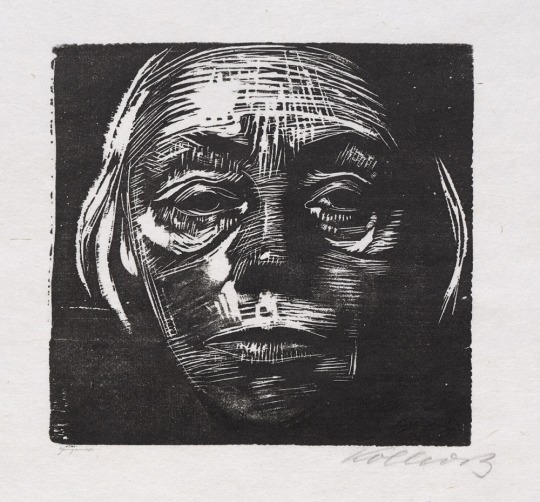
Selbstbildness von vorn, Käthe Kollwitz, 1922-1923. © 2019 Artists Rights Society (ARS), New York / VG Bild-Kunst, Bonn
I associate woodcuts with a particular aesthetic: they loom from their perch on the bookshelf in the den, next to a collection of Hans Christian Andersen tales, whose worn buckram binding is effusing that sapid antique book aroma which pairs so well with coffee and cake. In the corner of the room, above a worn black leather chair designated for tv-watching and reading, a pathos dangles from its pot, fed by gentle streams of light emanating from the canopy of shade sheltering the backyard garden. On weekends and special occasions, the clinking of cake forks against china is punctuated only by an occasional “delicious!” — direct and accurate. This orchestration produces a distinctly Germanic affect, and one that I associate with the elderly; the particular family room I’m recalling belonged to my next-door neighbors growing up, former members of the Danish anti-Nazi resistance who had emigrated in the early 1960s. While I can’t be sure there was any deeper meaning behind their affinity for the humble woodcut, I do recall the medium’s prominence in their home. For me, something as benign as a flock of birds is represented with a degree of melancholy in these prints’ impenetrable black shadows — an inevitability in this generation’s Weltanschauung, that everything beautiful carries with it a degree of pain, a nostalgia for the idea of a more civil world.

Without Title, Constantin von Mitschke-Collande, 1923 (?) © Oglethorpe University Museum of Art
These beloved octogenarians, Ketty and Eigil, were my first true role models, and I insisted on seeing them almost every day for the first decade of my life. They taught me what hygge was before it became a commodity, when it was an applied wisdom that emanated, more than anything, from common sense. I can still place myself their 1950′s minimal traditional home: running my hands along their walnut furniture as I toddled from room to room, greeted around each corner by the unique tick-tock of an antique clock, my slippers shuffling along the dull, greenish-blue carpet so typical of that era. Nothing in that home was remotely as paired down as today’s CB2 nonsense, and the old neighborhood still retained a smidgen of character unlike the suburbs to which my family would later relocate; lovingly tended beds of roses, pansies, and bleeding hearts grew around coy ponds under the shade of ancient maple and red oak.
Though they wouldn't have wanted it this way, I found the art in Ketty and Eigil's home to be inextricably linked to their brazen defiance in the face of Nazi terror. They seldom discussed their acts of resistance, almost never in front of children, and always with a healthy dose of embarrassment. For them, violence, even against evil, was never a source of pride. It was the democratic ideals to which they so stubbornly clung that were the real source of their identity: notions like neighborliness and helpfulness, belief in the healthcare and education systems. It wasn’t until years after their deaths that I detected any degree of paradox in their suburban American existence meshed with Scandinavian socialist ideals, was able to chuckle at their nostalgia for the old country as expressed in their grocery cart (tubs of frozen Coolwhip to be served generously with home-baked apple cake, slices of summer sausage or cucumber salad served on squares of cocktail rye, a far cry from the bakeries and delicatessens of northern Europe.)

A young family admires their new home. Between 1950 and 1970, America’s suburban population nearly doubled to 74 million. © Camerique Archive / Archive Photos / Getty Images
My association of woodcuts with Germanic Europe was solidified during my time as a High School exchange student in the rural Rheinland, and again during a semester abroad in Berlin. It seemed to me that, if one was of a certain generation and political bent, there was a good chance one might own such a print. But while I may associate woodcuts with the interior design choices of a singular socioeconomic stratum from the middle of the last century, its origins predate my concept of history. Woodcutting is thought to be the earliest print technique, originating in 9th-century China, and arriving in Europe sometime in the 14th century. Woodcut has been a staple medium for prominent Northern European artists like Dürer since the 16th century. To produce a print, artists carve their image into a block of wood, along the grain, removing the parts that will not carry ink. The surface is then rolled over with a brayer and the image transferred to a sheet of paper through a press. The result in works like Käthe Kollwitz’s Selbstbildness von vorn (1922-1923), pictured above, is nothing short of haunting — well-suited to the violently introspective tone of German Expressionism. Here’s a short demonstration:
undefined
youtube
Phil Sanders, Director of the Robert Blackburn Printmaking Workshop, demonstrates the pressure + ink relief process
0 notes
Text
Woodcuts in suburbia: melancholy, nostalgia, and resistance
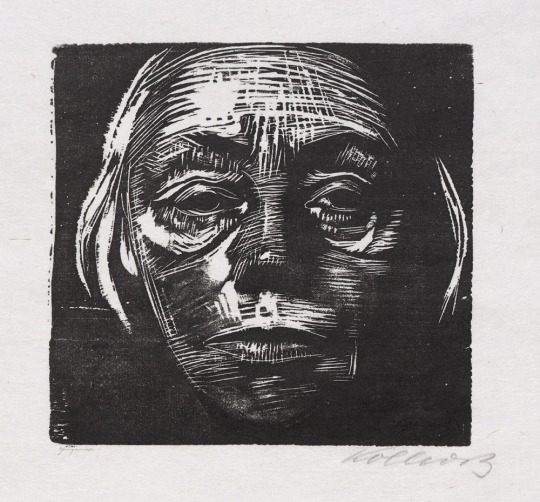
Selbstbildness von vorn, Käthe Kollwitz © 2019 Artists Rights Society (ARS), New York / VG Bild-Kunst, Bonn
I associate woodcuts with a particular aesthetic: they loom from their perch on the bookshelf in the den, next to a collection of Hans Christian Andersen tales, whose worn buckram binding is effusing that sapid antique book aroma which pairs so well with coffee and cake. In the corner of the room, above a worn black leather chair designated for tv-watching and reading, a pathos dangles from its pot, fed by gentle streams of light emanating from the canopy of shade sheltering the backyard garden. On weekends and special occasions, the clinking of cake forks against china is punctuated only by an occasional “delicious!” — direct and accurate. This orchestration produces a distinctly Germanic affect, and one that I associate with the elderly; the particular family room I’m recalling belonged to my next-door neighbors growing up, former members of the Danish anti-Nazi resistance who had emigrated in the early 1960s. While I can’t be sure there was any deeper meaning behind their affinity for the humble woodcut, I do recall the medium’s prominence in their home. For me, something as benign as a flock of geese is represented with a degree of melancholy in these prints' impenetrable black shadows — an inevitability in this generation’s Weltanschauung, that everything beautiful carries with it a degree of pain, a nostalgia for the idea of a more civil world.
These beloved octogenarians were my first choice of role models, and I insisted on seeing them almost every day for the first 8 or 9 years of my life. They were old-school Democrats (or at least, that’s how their values system translated into American) in a largely Republican suburb of a mid-sized Upper Midwestern city. I can still place myself their 1950′s minimal traditional home: running my hands along their walnut furniture with polished nickel handles, greeted by a different antique clock in every room, tick-tocking at various registers, my slippered feet shuffling along a dull, greenish-blue carpet so typical of that era. Nothing in that home was remotely as paired down as today’s sanitized mid-century throwback, and the old neighborhood still retained a smidgen of character unlike contemporary expressions of manifest destiny. Lovingly tended beds of roses, pansies, and bleeding hearts flourished under the shade of maples, walnuts, and red oak.

A young family admires their new home. Between 1950 and 1970, America’s suburban population nearly doubled to 74 million Camerique Archive / Archive Photos / Getty Images
For my neighbors, woodcuts seemed to be a culturally relevant way of displaying eerie alternative landscapes: a flock of geese, a school of fish, a sunset laden with a certain degree of subconsciously expressed Weltschmerz. For me, these woodcuts were inextricably linked to their stories of brazen defiance in the face of terror, which they seldom shared, always with a degree of pain and even embarrassment. Their democratic ideals to which they so proudly clung were the real source of their identity; it was from them that I learned it was OK to be gay, that everyone deserved a home and access to healthcare, that one lives like a society like a neighbor rather than just an individual. But it wasn’t until years after their deaths that I detected any degree of paradox in their suburban American existence, was able to chuckle at their nostalgia for the old country as expressed in their grocery cart (tubs of frozen Coolwhip to be served generously with home-baked apple cake, slices of summer sausage or cucumbers served on squares of cocktail rye, a far cry from the bakeries and delicatessens of northern Europe.)
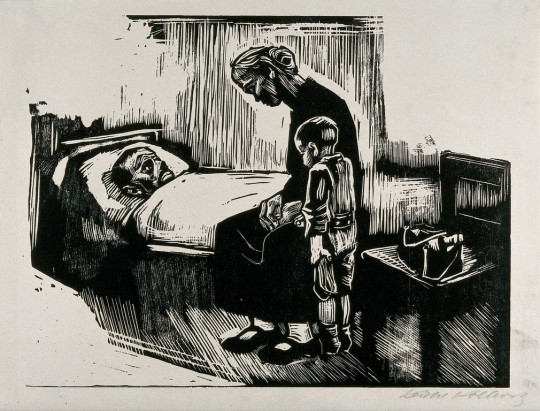
A woman and a boy visiting a man in hospital. Woodcut by Käthe Kollwitz, 1929. Credit: Wellcome Collection. CC BY
While I may associate woodcuts with the interior design choices of an immigrant family in the middle of the last century, its origins predate my concept of history. Woodcutting is thought to be the earliest print technique, originating in 9th-century China, arriving in Europe sometime in the 14th century. Woodcut has been a staple medium for prominent Northern European artists like Dürer since the 16th century. To produce a print, artists carve their image into a block of wood, along the grain, removing the parts that will not carry ink. The surface is then rolled over with a brayer and the image transferred to a sheet of paper through a press. The result in works like Käthe Kollwitz’s Selbstbildness von vorn (1922-1923), pictured above, is nothing short of haunting — well-suited to the violently introspective tone of German Expressionism. If you’re curious about the process, here’s a short demonstration:
undefined
youtube
Phil Sanders, Director of the Robert Blackburn Printmaking Workshop, demonstrates the pressure + ink relief process
Woodcutting became a popular tool of activists in the 1910′s, when thinkers like Ernst Barlach were beginning to use reductionist, anti-naturalist figures to express their dejection at the rise of an alien world. In the case of Barlach, his art was often placed alongside politically charged writing in order to provoke emotional reactions to the realities of uprootedness, inequality, and disaffection in industrialized, urban Europe. It is Barlach’s rather proletariat answer to the questions of modernity, inspired in part by a kind of political realism emerging in Russia, that inspired German artist Käthe Kollwitz to take up the humble woodcut.
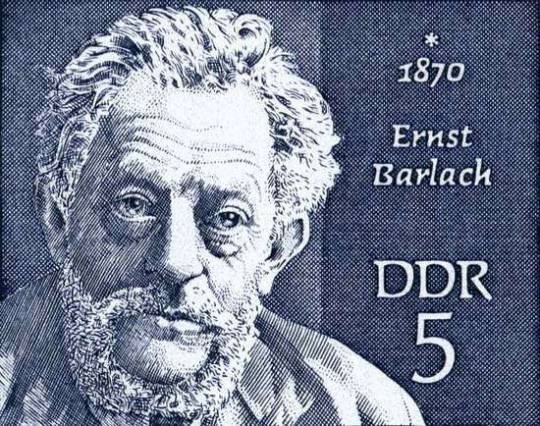
Ernst Barlach, from an East German stamp, 1970. Would he have been pleased with his legacy?
I remember receiving a story on the couch in my neighbors’ den — I was about 10 or 11 — regarding the final days of the war: a fellow member of the resistance had suggested replacing the Dannebrog with the flag of the Danish Communist Party, the DKP, an idea that had shaken my neighbor to his core. For him, resistance had been an act of preservation, a defense of the right to be distinctly Danish, and all that it entailed, in an increasingly international world. How the inability to return to a Denmark before the crimes of Nazism must have felt, I can only attempt to imagine. To this day, I am astounded by my neighbors’ apparent lack of burnout in light of what they sacrificed, their resilience in living out their ideals and inherited melancholia with me under an umbrella on the patio. It seemed that, for them, past and present far outweighed considerations for the future.
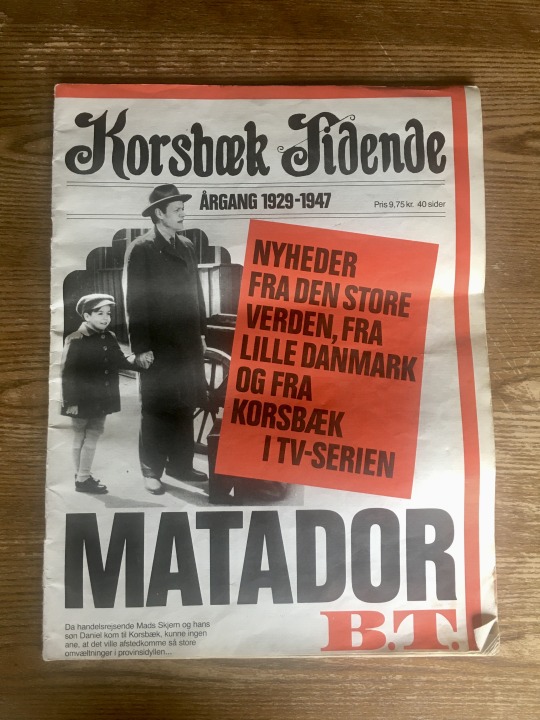
My copy of Korsbæk Tidende (Korsbæk Official Journal), an educational accompaniment to the popular Danish 1970′s and 1980′s tv-series “Matador” about a fictionalized Danish town between 1929 and 1947. I inherited this collection of real newspaper clips that informed events on the show from my neighbor — I assume he loved the show.
To an extent, I have inherited their idealism, an obsession with a bleak past used to check the present, an index of unwavering values to be accessed at any time. It is only through a sense of history that I’m able to make sense of the communicative power of images today, how calculated distortions of reality made ubiquitous through mass production can make us more empathetic, braver in the face of a not-so-distant future. It's a future that cannot be understood with the tools we have been given, that will almost upend our perceptions and unsettle us, a future that demands our bravery. More than ever my beloved neighbors ever could have fathomed, the possibility that our sacrifices will be bastardized in the name of another cause is unparalleled in the digital age. And even more than they experienced, we have the incredible opportunity, and challenge, to transplant our ideologies across ecosystems, upending heir original contexts.
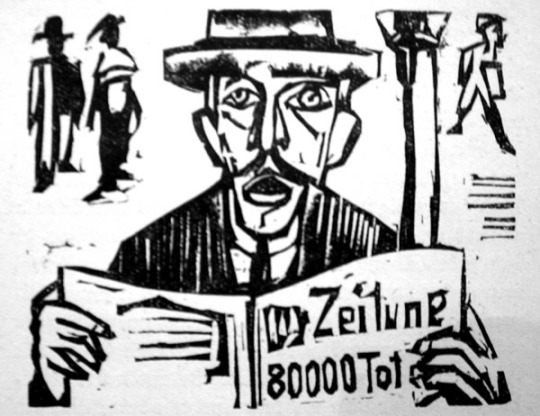
Simultaneous calls for universalism and individual freedom, the appeals of difference and homogeneity, the cogent argument of moral relativism against the call for a shared global narrative will, no doubt, continue to shake us in an era of unprecedented displacement and global climate change. Among other things, these challenges call for an art that, like the pervasive woodcut, infiltrates our purviews, and is attuned to the affect of contemporary life. It should carry with is a melancholic nostalgia, demand our empathy, blemish our idealized beauty.
If I limit myself to woodcuts, I'm reminded of the works of William Kentridge, Beatriz Milhazes, Leonard Baskin, Alison Saar, Irving Amen, Tony Bevan, Katsutoshi Yuasa, Assadour Bezdikian, Elizabeth Catlett, Lou Barlow, Leon Gilmour — I'm sure I'm missing countless others.
Retrospective Exhibitions on Käthe Kollwitz
Käthe Kollwitz, National Gallery of Art, Washington, D.C., 1992; Käthe Kollwitz: In Celebration of the 125th Anniversary of the Artist’s Birth, Galerie St. Etienne, New York City, 1992; Berner Kunstmuseum, Bern, Switzerland, 1946; Retrospective in honor of her 50th birthday at Paul Cassirer galleries, Berlin, 1917
Selected Bibliographies on Käthe Kollwitz
Knesebeck, Alexandra von dem. Käthe Kollwitz: Werkverzeichnis der Graphik. Band I & II. Bern: Kornfeld, 2002.
Prelinger, Elizabeth, ed. Käthe Kollwitz. Exh. cat. Washington, DC: National Gallery of Art, 1992.
Rix, Brenda D., and Jay A. Clarke. Käthe Kollwitz: The Art of Compassion. Exh. cat. Toronto: Art Gallery of Ontario, 2003.
Selected Bibliographies on Ernst Barlach
Laur, Elisabeth. Ernst Barlach: Sämtliche Werke, Werkverzeichnis I. Die Druckgraphik. Leipzig: E. A. Seemann, 2001.
Paret, Peter. An Artist Against the Third Reich: Ernst Barlach, 1933–38. Cambridge: Cambridge University Press, 2002.
Selected Bibliographies on Ernst Ludwig Kirnchner
Dube, Annemarie, and Wolf-Dieter Dube. Ernst Ludwig Kirchner: Das graphische Werk. 2 vols. Munich: Prestel, 1980.
Gercken, Günther, and Magdalena M. Moeller. Ernst Ludwig Kirchner: Farbige Druckgraphik. Exh. cat. Berlin: Brücke-Museum, 2008.
Krämer, Felix, ed. Ernst Ludwig Kirchner: Retrospective. Exh. cat. Frankfurt: Städel Museum, 2010.
Lloyd, Jill, and Magdalena M. Moeller, eds. Ernst Ludwig Kirchner, 1880–1938. Exh. cat. Washington, DC: National Gallery of Art, 2003.
Wye, Deborah. Kirchner and the Berlin Street. Exh. cat. New York: The Museum of Modern Art, 2008.
1 note
·
View note